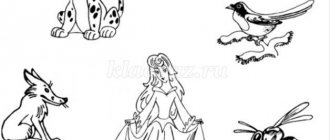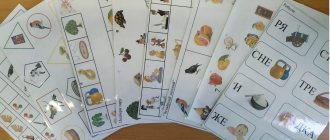Levina's method
Speech therapist R. E. Levina in 1965 developed a set of articulation exercises for teaching the pronunciation of “R”.
At the first stage, the exercises are aimed at obtaining the fricative "P" without vibration after achieving correct articulation.
On the second stage, the vibration of the tongue from the sounds “Ш”, “Ф” is trained. The child parts his lips without rounding them, extends the “F”, moves the tip of his tongue upward to the gums, there is no gap between them. The child exhales forcefully.
To generate vibration, use the sound “D”, which is pronounced in one exhalation. The mouth is wide open, the front edge of the tongue is tightly connected to the gums of the upper teeth. “D” is pronounced instead of “R” in words with the combination “TR” or “DR”.
Sound production methods
Tongue twisters for pronunciation of the sound “r”.
Basic staging techniques:
- By imitation - the child’s attention is fixed on movements, positions of the organs of articulation using visual and auditory control.
- Mechanically - using speech therapy probes, spatulas, hand tools.
- Mixed method - production from other sounds.
The period for fixing the correct sound is from 25 to 60 days. Lessons are held 2 times a week, without a speech therapist at home they study daily.
Imitation
Until the age of 6 years, pure “P” and “Pb” appear in children by imitation. The child masters articulation independently through phonemic perception, focusing on the speech of the people around him. Therefore, the pronunciation of adults should be clear and clear, without violations.
Setting "R" from the sound "D"
You can teach your child to say the letter “R”, starting from already formed sounds.
Setting from “D”:
- The child pronounces “D” loudly. The tip of the tongue rests on the alveoli of the upper palate. The tongue does not leave the palate.
- Repeat “Ddddd” without stopping. The tongue will vibrate and “DDD-RRR” will appear.
- Say the syllables DRA, DRO, DRU, DRE, DRA, in which the “R” sounds hard.
- Pronounce words that begin with “DR”, “TR”, practice pronunciation.
- Remove "D" from exercises.
If your child is unable to vibrate his tongue, you can help him by gently nudging his tongue with a popsicle stick.
Exercises from the sound “Zh”
If a preschooler pronounces “F” correctly, then when pronouncing it, you can move the tongue with a stick deeper into the mouth. A short “R” is formed. Strengthen it by repeating the exercises. After automating “R”, select words without using “F”.
Setting from the sound “Z”
The child pronounces “Z” briefly, lightly touching the alveoli with his tongue, and blows strongly on the tongue. A single-beat “P” will be heard, which then easily turns into a vibrating one.
This method is rarely used in practice, because The articulation of “R” and “Z” is different.
Exercises from the sound “C”
The child pulls “Ssssss” for a long time, then inhales through the mouth and presses the tongue to the alveoli. A short “P” will appear, which is automated through the exercises described above.
On inspiration
A distinctive feature of the above method is that the sound is caused by inhalation. Speech is built on a long exhalation, while the inhalation during speech breathing is short. But when placing “P” from “S”, the child makes a sound while inhaling air.
Ways to make the sound “r”.
Mechanical method
“P” is placed mechanically using speech therapy instruments. The child opens his mouth and raises his tongue to the sky. The speech therapist taps the alveoli with a hammer and adds vibration with a spatula. The sound is fixed with the help of exercises, vibration is practiced, first with a spatula, then without it.
Vibration of the tongue can be obtained in the following way: place a thick ball of paper (tied to a long thread) on the tip of the tongue, remove the tongue by the upper teeth and blow it off the tongue with a strong stream of air.
The mechanical method is used with caution in play so as not to injure the preschooler.
When correction is needed
The sound “R” is one of the most difficult sounds in a child’s speech development. It belongs to the category of sonorants, in which there are more vocal tones than noise.
Experts put “P” last, when all other sounds have already been correctly formed and consolidated. The production of “R” begins after 5.5-6 years. Until this time, a violation in his pronunciation is the age norm.
In some cases, it is worth contacting a speech therapist from the age of 4, when “R” appears in speech, but does not manifest itself correctly. In this variant, the child does not replace “R” with other sounds (“L”, “V”), but tries to pronounce “R”, but with disturbances in the articulatory apparatus.
Norm for pronunciation of “R”:
- lips are relaxed;
- distance between teeth 4-5 mm;
- the tip of the tongue rises to the upper gums;
- the tongue vibrates in the air stream;
- the middle part of the back of the tongue arches;
- the back of the tongue is directed back, pressed against the palate;
- the side edges are pressed upward;
- The vocal folds vibrate when speaking.
Violation of the pronunciation of hard “P” and soft “Pb” in defectology is called rhotacism or pararotacism. In Soviet times, these violations were called burrs.
The main types of rhotacism that require correction:
- Velar. The tip of the tongue is lowered down and does not participate in articulation. The tongue is tense and pushed back. There is little voice in pronunciation, a lot of air. The sound is guttural and loud.
- Uvular. The tongue vibrates in the air stream. The sound is soft, quiet, smooth.
- Nasal. The air is directed into the nose, there is no vibration.
- Bilabial. Only the lips, without the tongue, take part in articulation.
- Slotted. The tongue is directed upward and forms a gap with the soft palate. The sound changes to “Z” or “Zh”.
- Interdental. The tongue is between the teeth.
Stages of correction of violations:
- Preparatory.
- Sound production.
- Automation.
- Differentiation.
- Consolidation in speech.
Breathing exercises
Breathing speech therapy gymnastics:
- "Bubbles." Take a deep breath through your nose, puff out your cheeks and exhale through your mouth.
- "Mill". Feet together, arms up. Rotate with straight arms, saying “zh-r-r” as you exhale. Speed up movements, increase sound.
- "Geese." Walk around the room, flapping your arms like wings. Raise your arms as you inhale, lower them as you exhale, saying “g-oo-oo.”
- "Balloon". Lying on your back, place your hand on your stomach. Take a deep breath and exhale, observing the movement of your hand. Inflate your belly like a balloon.
- "Hedgehog". Imitation of a hedgehog puffing with tension in the muscles of the nasopharynx.
Reasons for incorrect pronunciation
A set of art exercises.
Forms of rotacism:
- Distorted pronunciation.
- Lack of sound in the child's speech.
- Replacing one sound with another.
Causes:
- Disorders of articulatory motility and the structure of the articulatory apparatus: short frenulum, narrow or enlarged tongue, malocclusion, lack of teeth, high palate.
- Violation of central regulation of breathing. The rhythm and coordination of inhalation and exhalation are disturbed. Exhalation occurs through the nose during throat pronunciation. The defects are caused by changes in muscle tone, limited mobility of the muscles of the larynx, soft palate, vocal folds, tongue and lips.
- Pedagogical neglect. The child does not hear literate speech in everyday situations; there is no literacy training. Adults consciously imitate his pronunciation, changing sounds, and do not correct incorrect sounds. They do not read literary works to a preschooler, nor do they have long conversations with him.
- Phonemic hearing impairment. The child does not distinguish phonemes of his native language, mixes them up, and does not understand the speech of others well.
Speech breathing problems
Speech breathing is the basis of spoken speech. It is responsible for voice-forming and articulatory functions. Speech breathing is the ability of a person to take a short, deep breath and distribute the air when exhaling while simultaneously pronouncing various sounds. Inhalation is 5-8 times shorter than exhalation. The long-term output is where speech is formed. With correct speech breathing, the child speaks clearly and expressively, observing pauses.
Preschoolers do not control themselves, they begin to speak while inhaling or on the residual output, and take in air before pronouncing each word. This affects correct pronunciation. If the child does not pronounce “R”, correction work should begin with breathing.
Hearing impairment
Phonemic hearing is the ability to distinguish, analyze and differentiate heard phonemes. From birth, children master their native speech by imitation. By the age of 4, a preschooler has developed the technique of pronunciation of all sounds, except sonorous ones.
Impaired phonemic hearing (dyslalia) complicates the perception of oral and written speech in school education, therefore, correction of defects is necessary as soon as they are detected.
Speech therapy exercises for the development of phonemic hearing, which parents can do independently:
- The adult names a series of sounds, and the child claps his hands when he hears the one in question.
- The adult claps his hands or taps a pencil in a rhythm that the child must repeat.
- The adult dictates sound combinations, the child repeats them.
- The adult shows the pictures, the child chooses those with the hidden sound.
- The adult names the words correctly and incorrectly, the child claps his hands when he hears the correct option.
Automation of the letter "P".
Insufficient development of speech organs
Immaturity of the speech apparatus is the main cause of pronunciation problems in preschool children. The speech apparatus consists of 2 sections: central (brain sections) and peripheral (tongue, lips, soft palate, lower jaw). Brain disorders are diagnosed and corrected by a neuropsychologist. Defects in the articulatory apparatus are eliminated by a speech therapist-defectologist in a playful manner.
Individual structure of the frenulum
A shortened frenulum and anomalies in its location are a defect of the oral cavity that occurs in early childhood. The problem can be effectively solved surgically; if you contact a specialist in a timely manner, the hypoglossal ligament is stretched with the help of exercises and speech therapy tools.






